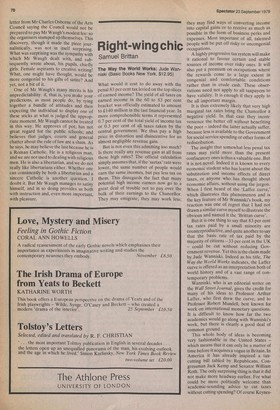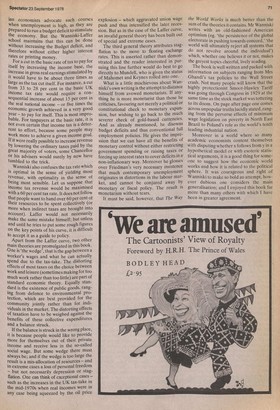Right-wing chic
Samuel Brittan
The Way the World Works: Jude Wanniski (Basic Books New York, $12.95) What would it cost to do away with the penal 83 per cent tax levied on the top slices of earned income? The yield of all taxes on earned income in the 60 to 83 per cent bracket was officially estimated to amount to £140 million in the last financial year. In more comprehensible terms it represented 0.7 per cent of the total yield of income tax or 0.3 per cent of all taxes taken by the central government. We thus pay a high price in distortion and disincentive for an almost negligible revenue gain.
But is not even this admitting too much? Is there really any revenue gain at all from these high rates? The official calculation simply assumes that, if the 'surtax' rate were lower, the same number of people would earn the same incomes, but pay less tax on them. This disregards the fact that many potential high income earners now go to a great deal of trouble not to pay over the bulk of their earnings to the Chancellor. They may emigrate; they may work less; they may find ways of converting income into capital gains or to receive as much as possible in the form of business perks and expenses. Most important of all, talented people will be put off risky or uncongenial occupations.
A highly progressive tax system will make it rational to favour certain and stable sources of income over risky ones. It will also put a premium on occupations where the rewards come to a large extent in congenial and comfortable conditions rather than in crude cash. These observations need not apply to all taxpayers to have validity. It is enough if they apply to the all important margin.
It is thus extremely likely that very high marginal tax rates bring the Chancellor a negative yield. In that case they inconvenience the better off without benefiting the poor — indeed the latter actually suffer, because less is available to the Government for social service spending or other forms of redistribution.
The insight that somewhat less penal tax rates may yield more than the present confiscatory ones is thus a valuable one. But it is not novel. Indeed it is known to every economic student who has learnt about the substitution and income effects of direct taxes, or anyone who has thought about economic affairs, without using the jargon. When I first heard of the `Laffer curve,' which illustrates this phenomenon and is the key feature of Mr Wanniski's book, my reaction was one of regret that I had not drawn a similar curve myself to illustrate the obvious and named it the 'Brittan curve'.
But it is one thing to say that 83 per cent tax rates paid by a small minority are counterproductive, and quite another to say that the basic rate of tax paid by the majority of citizens — 33 per cent in the UK — could be cut without reducing Government revenue. Yet this is the claim made by Jude Wanniski. Indeed as his title, The Way the World Works indicates, the Laffer curve is offered as an interpretation both of world history and of a vast range of contemporary problems.
Wanniski, who is an editorial writer on the Wall Street Journal, gives the credit for many of his ideas to Professor Arthur Laffer, who first drew the curve, and to Professor Robert Mundell, best known for work on international monetary questions. It is difficult to know how far the two academics would go along with Wanniski's work, but there is clearly a good deal of common ground This whole body of ideas is becoming very fashionable in the United States — which means that it can only be a matter of time before it acquires a vogue in Britain. In America it has already inspired a tax cutting bill tabled by Republicans, Congressman Jack Kemp and Senator William Roth. The only surprising thing is that it did not make more headway earlier. For what could be more politically welcome than academic-sounding advice to cut taxes without cutting spending? Of course Keynes ian economists advocate such courses when unemployment is high, as they are prepared to run a budget deficit to stimulate the economy. But the Wanniski-Laffer school maintains that this can be done Without increasing the Budget deficit, and therefore without either higher interest rates or printing money. . For a cut in the basic rate of tax to pay for itself by increasing the income base, the increase in gross real earnings stimulated by it would have to be about three times as large as the tax cut itself. For instance, a cut from 33 to 28 per cent in the basic UK income tax rate would require a consequential increase of about 15 per cent in the real national income — or five times the economic growth achieved in a very good year — to pay for itself. This is most improbable. For taxpayers at the basic rate, it is not even certain that income tax is a deterrent to effort, because some people may work more to achieve a given income goal. If it were really possible to increase revenue by lowering the ordinary taxes paid by the great majority of voters, some Chancellor or his advisers would surely by now have tumbled to the trick.
Wanniski also confuses the tax rate which is optimal in the sense of yielding most revenue, with optimality in the sense of being most sensible. Let us suppose that income tax revenue would be maximised with a 60 per cent tax rate. It does not follow that people want to hand over 60 per cent of their resources to be spent collectively (or more when indirect taxes are brought into account). Laffer would not necessarily make the same mistake himself; but unless and until he tries to put some rough figures on the key points of his curve, it is difficult to accept it as a guide to policy. Apart from the Laffer curve, two other main theories are promulgated in this book. • One is 'the wedge', that is the gap between a worker's wages and what he can actually Spend due to the tax-take. The distorting effects of most taxes on the choice between work and leisure (sometimes making for too much work rather than too little) are part of standard economic theory. Equally standard is the existence of public goods, ranging from defence to environmental protection, which are best provided for the Community jointly rather than for individuals in the market. The distorting effects of taxation have to be weighed against the benefits of these collective expenditures and a balance struck.
If the balance is struck in the wrong place, it is because people would like to provide more for themselves out of their pnvate income and receive less in the so-called social wage. But some wedge there must always be; and if the wedge is too large the result is a mis-allocation of resources — and in extreme cases a loss of personal freedom — but not necessarily depression or stagflation. One can think of exceptional cases — such as the increases in the UK tax-take in the mid-1970s when real incomes were. in any case being squeezed by the oil price explosion — which aggravated union wage push and thus intensified the later recession. But as in the case of the Laffer curve, an invalid general theory has been built out of special and extreme cases. The third general theory attributes stagflation to the move to floating exchange rates. This is asserted rather than demonstrated and the reader interested in pursuing this line further would do best to go directly to Mundell, who is given the status of Mahomet and Keynes rolled into one.
What is a little mischievous about Wanniski's own writing is the attempt to distance himself from avowed monetarists. If anything he is more monetarist than those he criticises, favouring not merely a political or constitutional check to monetary expansion, but wishing to go back to the much severer check of gold-based currencies. And as already mentioned, he disowns budget deficits and thus conventional full employment policies. He gives the impression that we can have all the benefits of monetary control without either restricting government spending or raising taxes or forcing up interest rates to cover deficits in a' non-inflationary way. Moreover he glosses over Friedman's very necessary insistence that much contemporary unemployment originates in distortions in the labour market, and cannot be conjured away by monetary or fiscal policy. The result is monetarism without tears.
It must be said, however, that The Way the World Works is much better than the sum of the theories it contains. Mr Wanniski writes with an old-fashioned American optimism (eg. 'the persistence of the global electorate in pushing towards concord,' the world will ultimately reject all systems that do not revolve around the individual') which, whether one believes it or not, makes the greyest topics cheerful, lively reading.
The book is well written and packed with information on subjects ranging from Mrs Ghandi's tax policies to the Wall Street crash. Not many people will know that the highly protectionist Smoot-Hawley Tariff was going through Congress in 1929 at the same time as the stock market was tottering to its doom. On page after page one comes across unpopular truths lucidly stated, ranging from the perverse effects of minimum wage legislation on poverty in North East Brazil to Poland's role as the world's tenth leading industrial nation.
Moreover in a world where so many academic economists content themselves with disputing whether x follows from y in a hypothetical model or with esoteric statistical arguments, it is a good thing for someone to suggest how the economic world works and how it is related to the political sphere. It was courageous and right of Wanniski to make so bold an attempt, however dubious one considers the main generalisation; and I enjoyed this book far more than many others with which I have been in greater agreement.



































































































 Previous page
Previous page